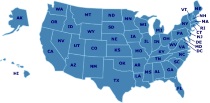Historic Sites
Learn through history by visiting interesting historic sites around the state of Wyoming. Historic sites let you put a real face on the history that you've read about, making it more exciting for you and your children.
Historic Sites in Wyoming
Pony Express National Historic Trail
The Pony Express National Historic Trail was used by young men on fast paced horses to carry the nation's mail across the country, from St. Joseph, Missouri to Sacramento, California, in the unprecedented time of only ten days. Organized by private entrepreneurs, the horse-and-rider relay system became the nation's most direct and practical means of east-west communications before the telegraph. Though only in operation for 18 months, between April 1860 and October 1861, the trail proved the feasibility of a central overland transportation route, and played a vital role in aligning California with the Union in the years just before the Civil War. Most of the original trail has been obliterated either by time or human activities. Along many segments, the trail's actual route and exact length are matters of conjecture. However, approximately 120 historic sites may eventually be available to the public, including 50 existing Pony Express stations or station ruins.
Fort Laramie National Historic Site
This unique historic place preserves and interprets one of America's most important locations in the history of westward expansion and Indian resistance. Established in 1834, Fort Laramie began as a fur trading post. By the 1840s, wagon trains rested and resupplied here, bound for Oregon, California and Utah. In 1849 as the Gold Rush of California drew more westward, Fort Laramie became a military post, and in 1876, Fort Laramie served as an anchor for military operations, communication, supply and logistics during the "Great Sioux War." Fort Laramie closed in 1890.
Mormon Handcart Historic Site at Martin's Cove
South of Riverton, Wyoming, the Mormon Handcart Companies has a Visitor's Center at Martin's Cove. You can get handcarts to trek into the cove both summer and winter.
Wyoming Frontier Prison
While outlaws roamed the windswept high plains, canyons and mountains of post Civil War Wyoming, the territorial legislature was planning a state-of-the-art penitentiary at Rawlins in anticipation of statehood. This new Wyoming State Penitentiary, which would serve from 1901 until 1981 would send a strong message to freewheeling desperadoes... Wyoming would no longer be a haven for the lawless. The Old Pen, as the Wyoming Frontier Prison is affectionately called today, is “haunted by history” around every corner. Tales of great train robbers, wily escapes and of women driven to crimes of passion are told on the scheduled guided tours offered from April through October. Group tours and off-season tours are also available.
Grand Encampment Museum
The Grand Encampment Museum, located in Encampment, Wyoming, preserves history with its collection of over a dozen historical buildings filled with artifacts representing the timber, mining, and agricultural history of the Encampment valley.
Featured Resources
As an Amazon Associate, we earn from qualifying purchases. We get commissions for purchases made through links on this site.
How to Drive: Real World Instruction and Advice from Hollywood's Top Driver
Want your child to be the best--and safest--driver possible? This book is for you! Ben Collins is a professional driver and is a former Top Gear Stig driver. He offers strategies for increasing control and safety and to encourage fun and efficient driving for all skill levels.
Safe Young Drivers: A Guide for Parents and Teens
Sixteen is by far the most dangerous age on the road. A 16-year-old is twelve times more likely than older drivers to die in a crash as a single occupant. Put two young teens in a vehicle, and the odds of death and injury nearly double. Despite these sobering facts, the procedure for obtaining a driver’s license in most states remains minimal. Commercial driving schools, even the most competent and conscientious among them, cannot possibly provide complete instruction. This book helps to address...
Educational Travel on a Shoestring : Frugal Family Fun and Learning Away from Home
Educational Travel on a Shoestring shows parents how they can help their children learn–and have a blast–while traveling. From researching destinations to sharing activities that both teach and entertain, this priceless guide offers practical information for parents who want to have more fun with their kids, build closer family ties, and enjoy richer educational experiences–all without spending a fortune.
Conquering Chronic Disorganization
The real-life stories of chronically disorganized people and the ground breaking, easy-to-learn organizing methods used to end their chronic disorganization in the area of residential clutter, office organizing, paper management, storage, and time management. Conquerings pages includes an extensive index, user-friendly summaries, quick tips, helpful photographs, and a resource section of products and organizations.
Great States Board Game
What is the capital of NJ? Where is the Football Hall of Fame? These are just a few of the hundreds of questions players are asked as they adventure around the USA discovering state attractions and landmarks, capitals, state abbreviations, state locations and more. In order to answer the questions on the cards, players must look closely at the colorful USA map game board, becoming familiar with the geography of the country. Players must hurry to find the answers as the mechanical timer ticks. Co...





